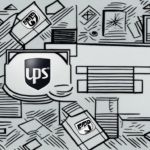Calculating Shipping Rates for a 168-Pound Package from Zip Code 33073 to 98290 with UPS
Shipping a heavy package weighing 168 pounds from zip code 33073 to 98290 requires a clear understanding of the factors that influence shipping costs. This guide provides a comprehensive approach to calculating UPS shipping rates, considering distance, zip codes, various UPS services, and effective strategies to minimize shipping expenses.
Understanding UPS Shipping Rates
UPS (United Parcel Service) is a leading global package delivery company that calculates shipping rates based on a combination of factors including weight, dimensions, shipping distance, and the selected service level. UPS's rate structure involves a zone system that segments the United States into different regions, with higher zones typically incurring higher shipping costs.
For heavy packages like a 168-pound shipment, UPS's shipping carriers offer specialized services such as freight shipping to accommodate large and heavy items. Additionally, UPS provides discounts for businesses that ship frequently or in large volumes, helping to reduce overall shipping expenses.
Additional services such as insurance, special handling for fragile or hazardous items, and expedited delivery options can also affect the total shipping cost. It's crucial to evaluate these options based on the value and nature of the items being shipped.
Factors Affecting Shipping Costs for Heavy Packages
- Weight and Dimensional Weight: Shipping costs increase with the weight of the package. UPS also considers dimensional weight, which accounts for the package's size in relation to its weight. This means that large, lightweight packages may be charged similarly to heavier ones.
- Shipping Distance: The distance between the origin and destination zip codes affects the shipping zone, thereby influencing the cost.
- Service Level: Different UPS services (e.g., Ground, Express, Freight) come with varying costs based on delivery speed and handling requirements.
- Fuel Surcharges and Additional Fees: Fluctuations in fuel prices and other surcharges can impact the final shipping cost.
- Packaging Materials: The type and quality of packaging can affect both the safety of the shipment and the overall cost.
Understanding these factors is essential for accurately estimating shipping costs and selecting the most cost-effective options for your needs.
Measuring the Weight of Your Package
Accurate weight measurement is critical for calculating shipping rates. For a 168-pound package, using a commercial-grade scale is recommended to ensure precision. Remember to include the weight of all packaging materials, such as boxes, padding, and tape, in the total weight.
Different shipping carriers have varying weight restrictions and pricing structures. For instance, UPS Freight handles shipments over 150 pounds, offering specialized services for heavy and bulky items.
Proper labeling with the correct weight and detailed shipping information helps prevent delays and ensures accurate billing. Additionally, consider purchasing insurance for valuable or fragile items to safeguard against potential loss or damage during transit.
Tips for Properly Packaging Heavy Items
- Use Sturdy Boxes: Select strong, durable boxes designed to handle heavy weights. Double-walled boxes are often recommended for added strength.
- Reinforce Seams and Corners: Use high-quality packing tape to secure all seams and corners, preventing the box from opening during transit.
- Employ Effective Padding: Utilize cushioning materials like bubble wrap, foam peanuts, or air pillows to protect the contents and absorb shocks.
- Distribute Weight Evenly: Ensure the weight is evenly distributed within the package to maintain balance and reduce the risk of damage.
- Label Clearly: Mark the package with clear labels indicating that it contains heavy items and should be handled with care.
Proper packaging not only protects your items but also helps avoid additional shipping fees related to damaged goods or improper handling.
How Distance Affects Shipping Costs
The distance between the origin and destination significantly impacts shipping costs. UPS's zone system classifies locations into zones based on their distance from the shipping origin. Shipping to higher zones, which are farther away, generally incurs higher costs.
For a package moving from zip code 33073 to 98290, determining the specific zones involved can provide a clearer estimate of the shipping cost. Utilizing UPS's zone calculator tool can help identify the exact zones and corresponding rates.
In addition to distance, the chosen shipping method (e.g., ground vs. air) will also influence the overall cost. Expedited services like UPS Express offer faster delivery times at a premium price compared to standard ground shipping.
The Role of Zip Codes in Shipping Rates
Zip codes are integral to calculating shipping rates as they determine the shipping zones utilized by UPS. Each zip code is assigned to a specific zone, and the combination of origin and destination zones influences the cost.
Accurate zip code entry ensures precise rate calculations and timely delivery. Tools such as UPS's Zone Lookup can help verify the correct zones for both the sending and receiving locations.
Using UPS's Online Rate Calculator
UPS provides an online rate calculator that simplifies the process of estimating shipping costs. To use the calculator effectively:
- Enter the package's weight and dimensions.
- Provide the origin and destination zip codes.
- Select the desired UPS service level.
The calculator will generate an estimated cost based on the provided information. It's important to review the final cost breakdown, including any additional fees or surcharges, before finalizing your shipment.
Understanding Different UPS Shipping Services
UPS offers a variety of shipping services tailored to different needs:
- UPS Ground: Ideal for non-urgent shipments, offering reliable delivery at a lower cost.
- UPS Air: Suitable for urgent or time-sensitive shipments, providing expedited delivery options.
- UPS International: Facilitates shipping to over 220 countries and territories, including customs clearance services.
- UPS Freight: Designed for large, heavy, or oversized shipments, offering specialized handling and flexible pickup options.
Each service comes with distinct features and benefits. For example, UPS Ground provides day-definite delivery and comprehensive tracking, while UPS Air services ensure next-day delivery with confirmation. Selecting the appropriate service depends on the package's size, weight, destination, and required delivery speed.
Comparing Rates Between UPS and Other Carriers
Evaluating shipping rates across different carriers can lead to significant savings. While UPS is a prominent choice, other carriers like FedEx, DHL, and USPS offer competitive rates and services:
- FedEx: Known for its extensive air network and reliable express services.
- DHL: Specializes in international shipping with robust global coverage.
- USPS: Often the most cost-effective option for smaller packages and offers a range of shipping speeds.
Comparing factors such as delivery speed, reliability, service options, and pricing can help determine the best carrier for your specific shipping needs. Tools like carrier comparison can assist in making an informed decision.
How to Save Money on UPS Shipping Costs
Reducing UPS shipping costs is achievable through several strategies:
- Consolidate Shipments: Combining multiple packages into a single shipment can lower overall costs.
- Negotiate Rates: Businesses that ship in large volumes may be eligible for discounted rates through negotiation with UPS.
- Utilize Online Tools: Leveraging UPS's online shipping tools can help compare rates and select the most cost-effective options.
- Flat-Rate Shipping: For packages under 50 pounds, UPS's flat-rate shipping options can offer predictable and often lower costs.
Implementing these cost-saving measures can lead to significant reductions in shipping expenses, especially for businesses with high shipping volumes.
Understanding Additional Fees and Surcharges
Beyond the base shipping rate, several additional fees and surcharges may apply:
- Fuel Surcharges: Fluctuating fuel prices can lead to variable surcharges.
- Residential Delivery Fees: Delivering to residential addresses may incur extra charges compared to commercial deliveries.
- Delivery Area Surcharges: Remote or hard-to-reach locations might attract additional fees.
- Special Handling Fees: Packages requiring extra care or handling may be subject to surcharges.
Understanding these potential additional costs helps in budgeting accurately and avoiding unexpected expenses at the time of shipment.
Tips for Negotiating Shipping Rates with UPS
Businesses that consistently ship large volumes can benefit from negotiating better rates with UPS. Here are some tips to facilitate successful negotiations:
- Present Shipping Volumes: Demonstrating high shipping volumes can strengthen your position for discounts.
- Propose Long-Term Contracts: Committing to a longer-term partnership may result in more favorable rates.
- Explore Alternative Services: Being flexible with service levels or delivery times can open opportunities for cost reductions.
Engaging with a UPS account representative to discuss your shipping needs and exploring available discount programs can lead to significant savings.
How to Track Your Shipment Once It's Been Sent
Monitoring your shipment ensures that it arrives on time and in good condition. UPS offers multiple tracking options:
- Online Tracking: Entering your tracking number on the UPS website provides real-time updates on your shipment's status.
- Mobile Tracking: The UPS mobile app allows for convenient tracking on the go.
- Email Notifications: Signing up for email alerts keeps you informed of any status changes or delivery confirmations.
Regularly tracking your shipment helps in proactively addressing any potential delays or issues that may arise during transit.
Conclusion
Accurately calculating shipping costs for a heavy package with UPS involves understanding various factors such as weight, dimensions, distance, service levels, and additional fees. By measuring your package correctly, choosing the appropriate UPS service, and implementing cost-saving strategies, you can optimize your shipping process effectively. Leveraging UPS's online tools and considering alternatives can further enhance your ability to manage and reduce shipping expenses, ensuring that your package reaches its destination efficiently and cost-effectively.






















